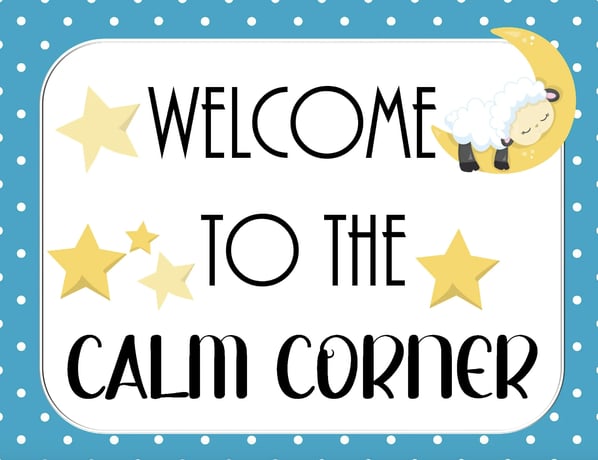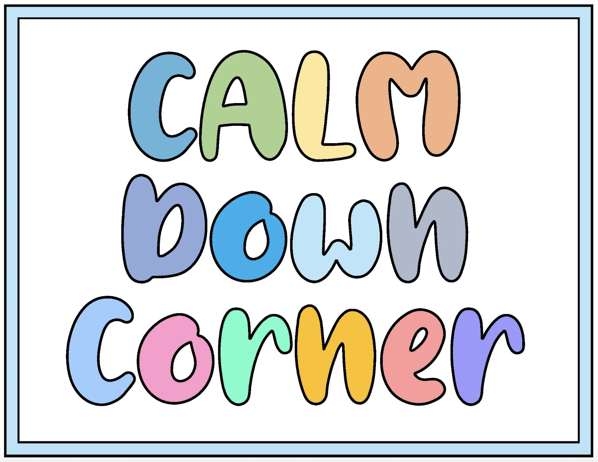
As children develop and grow their understanding of themselves and the world around them, their emotions may be intense or overwhelming. Giving them various tools, strategies, and resources for managing their emotions can be a big help. One of the tools you may choose to implement in your classroom is a calm down corner.
Read on to learn more about calm down corners, how to create one for your classroom, and ideas to inspire your own.
What is a calm down corner?
When children struggle with their emotions, they may yell, cry, exhibit challenging behavior, or do whatever they can to release some of their feelings. Teaching children emotional self-regulation strategies helps them learn to manage big emotions and feelings. A calm down corner is a great tool for learning to self-soothe. It’s a special area of the classroom with various calming or distracting elements for children to use when their emotions feel too big for them.
The goal of a calm down corner is to provide a designated area where children can choose for themselves what they need to feel better. It’s important to provide a specific space where children can go to feel safe and calm on their own. This helps you continue managing your classroom by preventing them from distracting the rest of the class. It encourages children to regulate and reflect on their emotions and then jump back into participating with their peers.
How to create a calm down corner in classroom
When creating a calm down corner for your classroom, remember that it’s a resource for your children. Take time to build something that fits your teaching style, children, and classroom. Check out these helpful tips below for inspiration and direction along the way.
Start with the base
Ideally, a calm down corner should be placed in a corner of your classroom to make it extra cozy, private, and comforting. You can also hang a canopy from the ceiling or add some sort of partition to give it a similar effect no matter where it is and provide some privacy. Cover the floor with a rug or blanket for children to sit on. Also, ensure it’s well-organized with plenty of storage to keep it tidy.
Incorporate sensory play
There are tons of opportunities for sensory play in a calm down corner. An extra soft rug, fluffy pillows, and textured blankets are all a good place to start. Then, you can add things like a sensory bin, sensory toys, or sensory bottles. These elements are important because they promote social-emotional development, especially the ability to regulate emotions.
Add comforting objects
Children should feel safe and comfortable in the calm down corner. Keep a variety of quiet toys, stuffed animals, and even plants in the area. You can even post pictures of familiar characters from TV or books to give children a sense of company.
Include resources
Children are still developing their basic understanding of their own emotions and the emotions of others. Giving them resources about what they might be experiencing can help them process it. Provide resources like children’s books about tough feelings or a big chart that identifies different emotions so they can point to what they’re feeling.
Expand to your whole classroom
Creating an overall culture of emotional awareness in your classroom can also make the calm down corner even more effective. Build in moments to check in and reflect with your class each day and integrate mindfulness activities and practices into your lesson plans. Use a tool like brightwheel’s daily activity report feature to track each child’s emotional development milestones, communicate them to families, and schedule activities to incorporate mindfulness into each day.
Calm down corner ideas
Bring your own creativity into your classroom’s calm down corner. Mold the space into something that fits your children’s needs. Check out these ideas for some inspiration as you work on it.
- Chart of yoga poses: Some children may want to do something physical to help regulate their emotions. Giving them a chart of yoga poses provides ideas for how they can move their body in a positive way.
- Soothing music: Classical music, piano music, or fun children’s music will help children who prefer auditory stimulation. Don’t forget to provide headphones as well.
- Sensory items: There are endless options for adding sensory play, such as sensory bins, sensory bottles, and sensory toys. Each type of sensory item is important for developing fine motor skills, engaging the senses, and providing a physical outlet for emotions.
- Books: Children’s books that center on social-emotional topics can help children understand the emotions they might be feeling. You can also choose books that teach breathing exercises or meditations.
- Coloring books: Age-appropriate coloring books are a great activity for children to focus their minds on. Offer a variety of books and utensils for coloring.
- A timer: You can set a time limit for your calm down corner to encourage children to use it as needed and then rejoin the rest of the class. Choose a maximum time and set the timer for each child as they start utilizing the space.
- Stuffed animals: Children may want to hold, squeeze, or cuddle with a stuffed animal for comfort. Provide a variety of shapes and sizes for them to choose from.
Calm down corner sign
Make a sign that clearly designates the area as a calm down corner. Make it colorful and inviting to make it clear that it isn’t a punishment corner or time-out corner. You may also include a suggested schedule of activities underneath your sign to give children an idea of how they can use the space. Here are some free examples you can use:


Final thoughts
Creating a dedicated calm down corner provides children with a safe and comforting space where they can regulate their emotions, self-soothe, and regain control during moments of stress or overwhelm. By incorporating sensory elements, such as soft textures, calming colors, and gentle sounds, the calm down corner promotes relaxation and encourages self-reflection.
By prioritizing the creation of a calm down corner, you can empower little learners to navigate their emotions effectively and foster a sense of emotional well-being that extends far beyond the preschool years.
Brightwheel is the complete solution for early education providers, enabling you to streamline your center’s operations and build a stand-out reputation. Brightwheel connects the most critical aspects of running your center—including sign in and out, parent communications, tuition billing, and licensing and compliance—in one easy-to-use tool, along with providing best-in-class customer support and coaching. Brightwheel is trusted by thousands of early education centers and millions of parents. Learn more at mybrightwheel.com.

